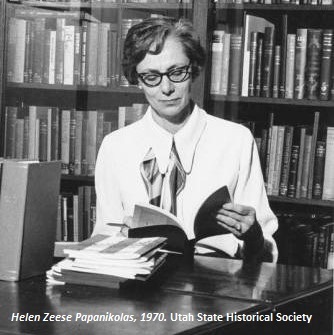Dublin Core
Title
Description
A famous historian used her girlhood memories of Carbon County to completely change the way we understand Utah’s past.
She passed away in 2004, but Helen Zeese Papanikolas is still revered in Utah as an historian whose work made it impossible to ignore the complexities of Utah’s past and present. Throughout her 50-year career, she documented the stories of immigrants and promoted an inclusive view of Utah’s diverse ethnic heritage. But who was Helen Papanikolas? Where did she come from? What is her story?
Born in 1917 in Carbon County, Helen was the daughter of Greek immigrants. Growing up in the mining and railroad town of Helper, Helen knew diversity, for she was constantly surrounded by Italians, Greeks, Irish, Serbs, Croats, Slovenes, Japanese, and Americans. She remembered religious differences and the shouted insults between the Mormon and Italian boys. She remembered feeling different, having to attend Greek classes after her regular school day, and trying to hide her Greek books in her desk so the other children wouldn’t see. As a young girl in the 1920s, Helen witnessed the funeral train for a Greek man killed in a nationwide coal strike, and was shaped by dark memories of the devastating Castle Gate mining disaster and of Ku Klux Klan activities in Carbon County.
As a teenager Helen’s family moved to Salt Lake City, where she attended the University of Utah. Her ambition was to become a doctor, but she also loved to write. While studying for a degree in bacteriology, she worked as an editor for the University’s literary magazine. And so her writing career began. Helen graduated from college, married and had two children, and still she wrote, trying her hand at novels and short stories. Holding firm to her Greek heritage, she used that for the basis of her first publication in 1954, an article for the Utah Historical Quarterly called “The Greeks of Carbon County,” influenced no doubt by her childhood experiences.
That article marked a major shift in the kind of history published in Utah, and led to many other works, including her 1976 book, The Peoples of Utah, which has been acclaimed as an undeniable celebration of Utah’s rich ethnic history.
Creator
Source
Image: Helen Zeese Papanikolas, 1970. #13241. Courtesy of Utah State Historical Society.
_______________
Murphy, Miriam B., “Helen Zeese Papanikolas: A Unique Voice in America,” Worth Their Salt: Notable But Often Unnoted Women of Utah, edited by Colleen Whitley, Logan: Utah State University Press, 1996, pp. 243-256.

